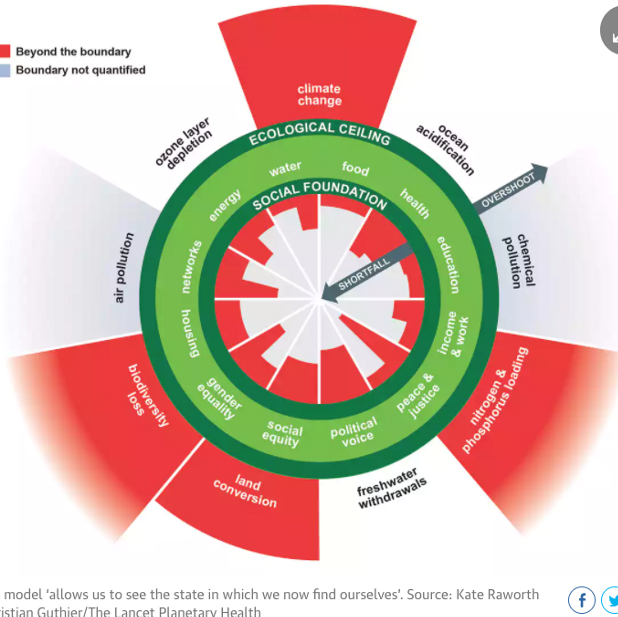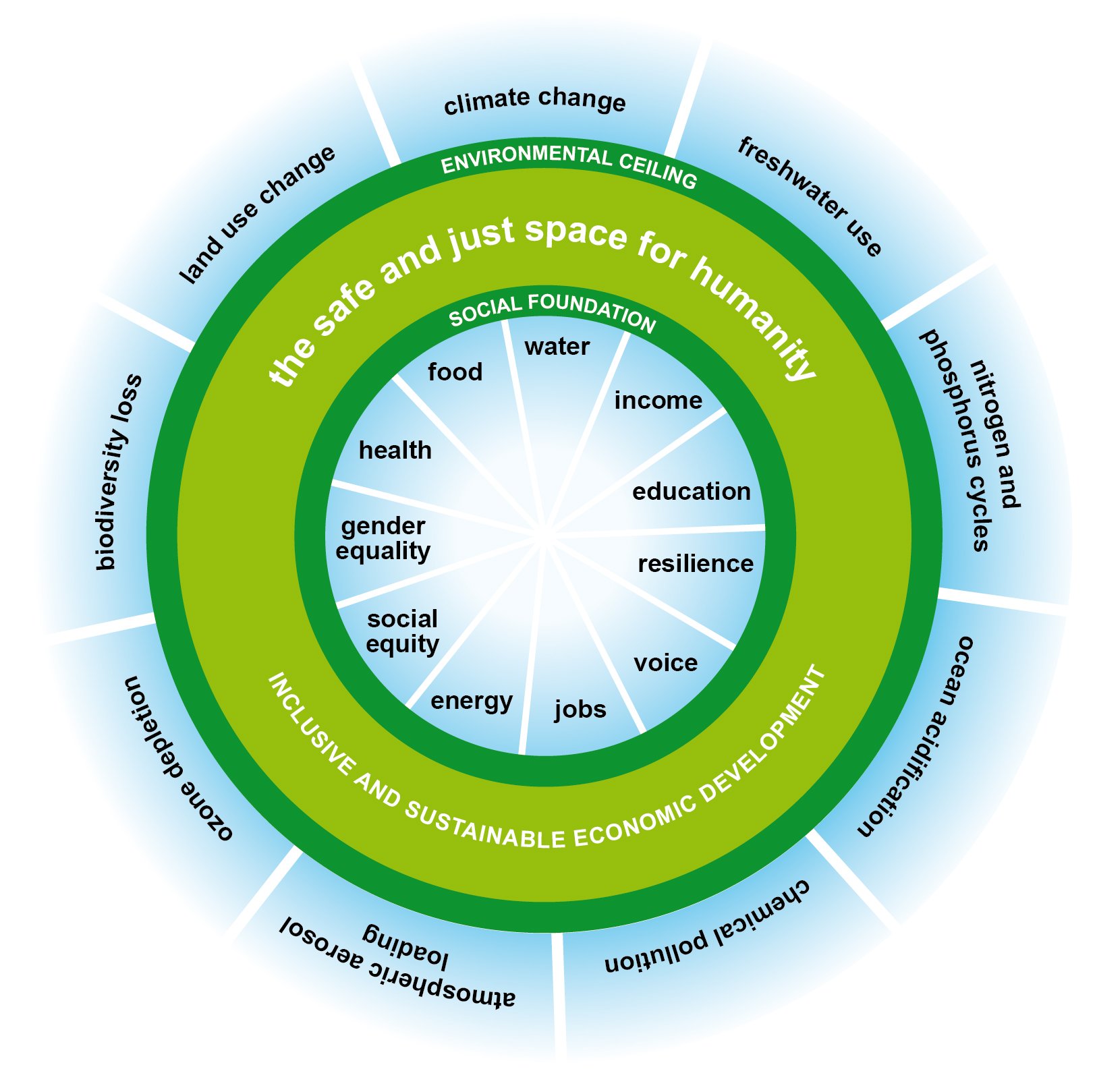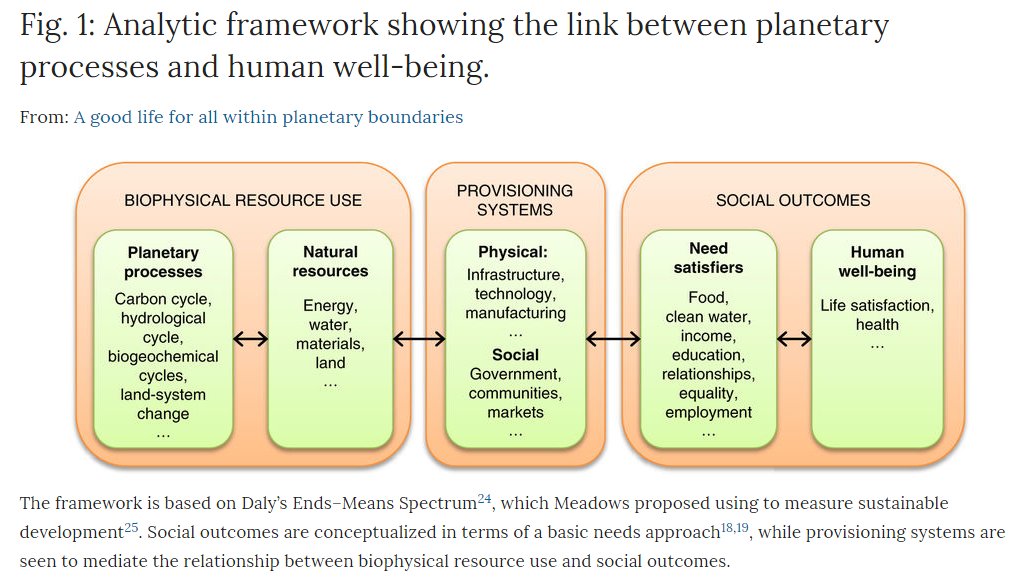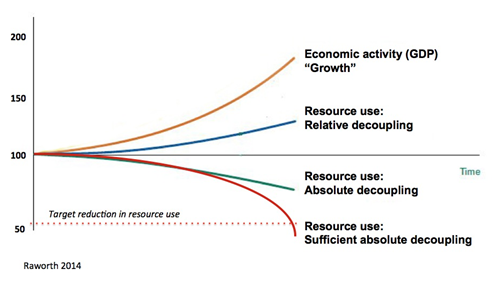INTERESTING IDEAS
DOUGHNUT ECONOMICS
An IDEA articulated by Kate Rayworth
|
|
|
Kate-Raworth-Econ-101-Quiz-What-century-are-you-in-140929
What century are you in? The Econ 101 quiz… a series of questions to show how ineffective much of conventional economic thinking has been.
TPB Note: It is good and thought-provoking except that it does not really go far enough. The TVM approach is to start putting all of the Raworth ideas into a framing that is compatible with the way financial reports are prepared ... that is opening balance sheet, closing balance sheet and the intervening P&L account, but doing this for ALL the CAPITALS and not merely those that relate to conventional economics and finance.
|
|
'http://truevaluemetrics.org/DBpdfs/Ideas/KateRaworth/Kate-Raworth-Econ-101-Quiz-What-century-are-you-in-140929.pdf
| Open PDF ...
Kate-Raworth-Econ-101-Quiz-What-century-are-you-in-140929
|
Kate-Raworth-Oxfam-Discussion-Paper-a-safe-and-just-space-for-humanity-130212
SUMMARY: Humanity’s challenge in the 21st century is to eradicate poverty and achieve prosperity for all within the means of the planet’s limited natural resources. In the run-up to Rio+20, this discussion paper presents a visual framework – shaped like a doughnut – which brings planetary boundaries together with social boundaries, creating a safe and just space between the two, in which humanity can thrive. Moving into this space demands far greater equity – within and between countries – in the use of natural resources, and far greater efficiency in transforming those resources to meet human needs.
|
|
'http://truevaluemetrics.org/DBpdfs/Ideas/KateRaworth/Kate-Raworth-Oxfam-Discussion-Paper-a-safe-and-just-space-for-humanity-130212.pdf
| Open PDF ...
Kate-Raworth-Oxfam-Discussion-Paper-a-safe-and-just-space-for-humanity-130212
|
|
|
IMAGES FOR DOUGHNUT ECONOMICS
|
GO TOP
|

|
This diagram shows a lot
As regards SOCIAL performance ...
There are these shortfalls:
... Food ... modest shorfall
... Health ... serious shortfall
... Education ...
... Income and work
... Peace and justice ... some OK, some terrible
... Political voice ... serious shortfall
... Social equity ... serious shortfall
... Gender equality ... some terrible
... Housing
... Networks ... some not good
... Energy
... Water
As regards ENVIRONMENTAL performance ...
There are mainly overshoots :
... Climate change ... mossive overshoot
... Ocean acidification ... boundary not defined
... Chemical pollution ... boundary not defined
... Nitrogen and phophorus loading ... overshoot
... Freshwater withdrawals ... boundary not defined
... Land conversion ... overshoot
... Biodiversity loss ... serious overshoot
... Air pollution ... boundary not defined
... Ozone layer depletion ... boundary not defined
|
The issues with this presentation
In order to MANAGE change, a diagram must have an ability to show not only STATE but progress. This is very difficult with any diagram that presents the information using some form of circle.
In order to get ACTION, it must be possible to disaggregate the presentation in a way that enables focus on the specific performance of the specific actor. There are no 'actors' that can identify with the global situation ... everything is local.
In this diagram there is the label 'boundary not yet identified' which may be true at the planetary level, but at a local level organizational behavior that is going to result in ocean acidification, chemical pollution, air pollution or ozone layer depletion may be identified as bad behavior.
A 'planetary boundary' is one of the elements used in the numbering or quantification within the TVM Standard Value Profile (SVP). To the extent that these have not been computed for the planet, it is perfectly possible to substitute a boundary that applies to the 'average' place. The actual value profile that emerges in any specific situation will depend on all the parameters and especially the paramters that relate to a specific place.
|

|
|

|
|
|
|
DOUGHNUT ECONOMICS AND THE SDGs
|
GO TOP
|
|
|
LEEDS UNIVERSITY ANALYSIS USING DOUGHNUT ECONOMICS FRAMEWORK
|
GO TOP
|
University-of-Leeds-Research ... The Living Well Within Limits (LiLi) project
The Living Well Within Limits (LiLi) project is a Leverhulme Research Leadership Grant awarded to Dr Julia Steinberger. LiLi addresses crucial but understudied questions: What are the biophysical resources, more specifically energy, required to achieve human well-being? What influence do social and technical provisioning systems have on the levels of resource use associated with well-being? If remaining within planetary boundaries requires rapid decreases in resource & energy use, how could these scarce resources best be employed to enhance and preserve well-being?
|
About the LiLI Project
https://lili.leeds.ac.uk/
| Open external link
|
University-of-Leeds-2018-Analysis ... A good life for all within planetary boundaries
by Daniel W. O’Neill 1 *, Andrew L. Fanning 1 , William F. Lamb 2 and Julia K. Steinberger 1
1 Sustainability Research Institute, School of Earth and Environment, University of Leeds, Leeds, UK.
2 Mercator Research Institute on Global Commons and Climate Change (MCC), Berlin, Germany.
*e-mail: d.oneill@leeds.ac.uk
Humanity faces the challenge of how to achieve a high quality of life for over 7 billion people without destabilizing critical planetary processes. Using indicators designed to measure a ‘safe and just’ development space, we quantify the resource use associated with meeting basic human needs, and compare this to downscaled planetary boundaries for over 150 nations. We find that no country meets basic needs for its citizens at a globally sustainable level of resource use. Physical needs such as nutrition, sanitation, access to electricity and the elimination of extreme poverty could likely be met for all people without transgressing planetary boundaries. However, the universal achievement of more qualitative goals (for example, high life satisfaction) would require a level of resource use that is 2–6 times the sustainable level, based on current relationships. Strategies to improve physical and social provisioning systems, with a focus on sufficiency and equity, have the potential to move nations towards sustainability, but the challenge remains substantial.
'http://truevaluemetrics.org/DBpdfs/Ideas/KateRaworth/University-of-Leeds-2018-Analysis.pdf'
|
Open PDF ...
University-of-Leeds-2018-Analysis
|
University-of-Leeds-2018-supplementary-information ... A good life for all within planetary boundaries
'http://truevaluemetrics.org/DBpdfs/Ideas/KateRaworth/University-of-Leeds-2018-supplementary-information.pdf'
| Open PDF ...
University-of-Leeds-2018-supplementary-information
|

TPB Note: This image originated with Herman Daly in the 1970s. In my view it can be made very much more powerful by combining these ideas with those of conventional double entry accountancy where there is a clear differentiation between the STATE (Balance Sheet) and the FLOWS (P&L Account) ... where there is a BEFORE STATE and an AFTER STATE.
While conventional accountancy only thinks in terms of money transactions and the financial impact on the organization, the TrueValueMetrics impact analysis thinks in terms of the IMPACTS on ALL of the CAPITALS, but still using the classic accountancy conventions.
|
|

|
Resource Decoupling
Though there is more talk about business behaving more sustainably, the underlying reality is that almost every company still operates in a manner that is unsustainable. Accordingly a TVM priority is to help companies to measure the extent of unsustainability, together with all the other actors in the socio-enviro-economic system
|
A good life for all within planetary boundaries
Daniel W. O’Neill, Andrew L. Fanning, William F. Lamb, and Julia K. Steinberger
This spreadsheet contains the country-level data for the 7 biophysical and 11 social indicators generated in our analysis.
Biophysical data are normalised to the per capita biophysical boundary for each indicator, such that a value of 1 represents the biophysical boundary.
Social data are normalised to the sufficiency threshold for each indicator, such that a value of 1 represents the threshold associated with a 'good life'.
GHGs
Phosphorus
Nitrogen
Blue Water
eHANPP
Ecological
Materials
Life Satisfaction
Life Expectation
Nutrition
Sanitation
Income
Energy
Education
Services
Democracy
Equality
Employment
Life Satisfaction Nutrition Income Education Democracy Employment
Life Expectation Sanitation Energy Services Equality
|
|
Natural and socioeconomic determinants of the embodied human appropriation of net primary production and its relation to other resource use indicators.
Haberl H1, Steinberger JK, Plutzar C, Erb KH, Gaube V, Gingrich S, Krausmann F.
Author information
Abstract
Indicators of resource use such as material and energy flow accounts, emission data and the ecological footprint inform societies about their performance by evaluating resource use efficiency and the effectiveness of sustainability policies. The human appropriation of net primary production (HANPP) is an indicator of land-use intensity on each nation's territory used in research as well as in environmental reports. 'Embodied HANPP' (eHANPP) measures the HANPP anywhere on earth resulting from a nation's domestic biomass consumption. The objectives of this article are (i) to study the relation between eHANPP and other resource use indicators and (ii) to analyse socioeconomic and natural determinants of global eHANPP patterns in the year 2000. We discuss a statistical analysis of >140 countries aiming to better understand these relationships. We found that indicators of material and energy throughput, fossil-energy related CO2 emissions as well as the ecological footprint are highly correlated with each other as well as with GDP, while eHANPP is neither correlated with other resource use indicators nor with GDP, despite a strong correlation between final biomass consumption and GDP. This can be explained by improvements in agricultural efficiency associated with GDP growth. Only about half of the variation in eHANPP can be explained by differences in national land-use systems, suggesting a considerable influence of trade on eHANPP patterns. eHANPP related with biomass trade can largely be explained by differences in natural endowment, in particular the availability of productive area. We conclude that eHANPP can deliver important complimentary information to indicators that primarily monitor socioeconomic metabolism.
KEYWORDS:
CO2 emissions; Cross-country analysis; DEC, domestic energy consumption; DMC, domestic material consumption; EF, ecological footprint; Ecological footprint; Embodied HANPP (eHANPP); GDP, gross domestic product; HANPP, human appropriation of net primary production; Human appropriation of net primary production (HANPP); NPP, net primary production, i.e. the yearly biomass production of plants; NPP0, NPP of potential natural (=undisturbed) vegetation; NPPact, NPP of the currently prevailing vegetation; NPPh, NPP harvested or destroyed during harvest; NPPt, NPP remaining in the ecosystem after harvest; Socioeconomic metabolism; TPES, total primary energy supply; eHANPP, embodied HANPP; ΔNPPLC, change in NPP resulting from land conversion (defined as NPP0 − NPPact)
|
|
|
|

